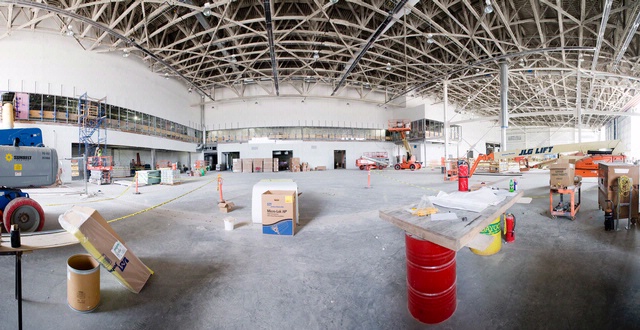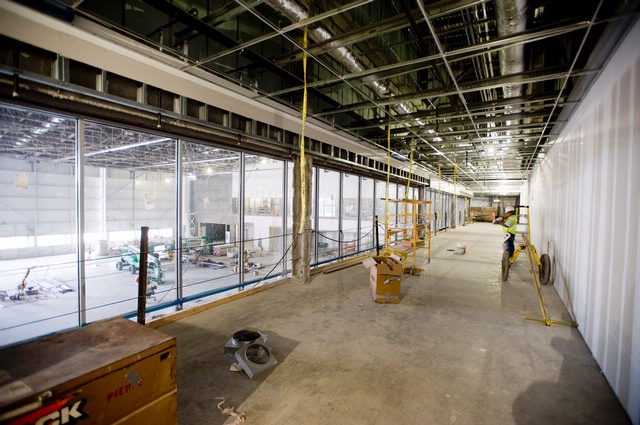
Aug 27, 2010
By Ciara Richards is an intern in the Aeronautics Division of the National Air and Space Museum.
Looking at the seemingly endless aisles of crates at the Paul E. Garber Restoration and Storage Facility, it is not a great stretch of the imagination to picture Indiana Jones scouring these narrow labyrinths for that anonymous wooden crate housing the notorious Ark. Images of Garber bring to mind the sheer size of the Museum’s collection of aircraft, spacecraft, related artifacts, and archival materials--a collection that, with some 60,000 artifacts, is the largest of its kind. It is hard for me to keep my jaw from dropping to the ground when I think of its enormity, value, and historic significance.
Garber’s staff works tirelessly to preserve and restore this immense collection of historic and iconic artifacts. However, working conditions are less than ideal as limited space and equipment hinder the progress of various projects. This will all change with the completion of the new wing of the Steven F. Udvar-Hazy Center—“Phase Two”—which will be dedicated to the behind-the-scenes care of the collection. The new wing, which will be furnished with state-of-the-art equipment and provide roughly three and a half times more space than Garber, will greatly aid staff in their work to restore, process, store, and conserve the collection. Located south of the James S. McDonnell Space Hangar at the Udvar-Hazy Center, Phase Two will include five facilities: the Mary Baker Engen Restoration Hangar, Collections Storage, Archives, the Emil Buehler Conservation Laboratory, and the Collections Processing Unit.

Providing about three and a half times more space and furnished with state-of-the-art equipment, Phase Two will make the work of preserving and restoring the Museum’s collection much easier.
The Mary Baker Engen Restoration Hangar will be able to house several aircraft at one time, giving specialists the space and resources to restore and maintain artifacts. The additional room and equipment will allow the Museum to resume various restoration projects, such as that of the Curtiss SB2C-5 Helldiver—the same type of aircraft that former director of the National Air and Space Museum, Donald Engen, flew in World War II. And perhaps the most exciting part of this new hangar is the glassed-in mezzanine that will allow the public to catch a glimpse of Museum specialists in action. So keep your eyes peeled for that Helldiver when Phase Two is complete.

An observation deck overlooking the restoration hangar will give the public a rare opportunity to observe firsthand the process of restoring aircraft and spacecraft.
The new collections storage space will eventually allow for all artifacts to be moved from Garber to the more modern facility, enabling staff to preserve and store artifacts more efficiently. The two-level facility will include environmental controls, compact shelving, and special storage units. This will allow the Museum to maximize storage space while effectively storing a diverse collection of objects ranging from commemorative medals to large power plants, and even wolf fur used in the Arctic, to mention a few. Not to forget about the valuable and rare records in the Museum’s hands, the archives will house more than 12,000 cubic feet of documentation in addition to more than 1.75 million photographs and 14,000 film and video titles. The Emil Buehler Conservation Laboratory will further aid staff by providing guidance on storage and exhibition conditions as well as innovative treatment plans for preservation. The new collections processing area will consist of a special loading dock and secure area where artifacts can be inspected; cleaned; assembled and disassembled; and wrapped and protected for optimum preservation. The completion of the new wing will provide the Museum with a modern facility that will help behind-the-scenes staff with their important work. It will ultimately bring the Museum one step closer to accomplishing its mission to collect and preserve the nation’s aviation and space history.

We rely on the generous support of donors, sponsors, members, and other benefactors to share the history and impact of aviation and spaceflight, educate the public, and inspire future generations. With your help, we can continue to preserve and safeguard the world’s most comprehensive collection of artifacts representing the great achievements of flight and space exploration.
We rely on the generous support of donors, sponsors, members, and other benefactors to share the history and impact of aviation and spaceflight, educate the public, and inspire future generations. With your help, we can continue to preserve and safeguard the world’s most comprehensive collection of artifacts representing the great achievements of flight and space exploration.